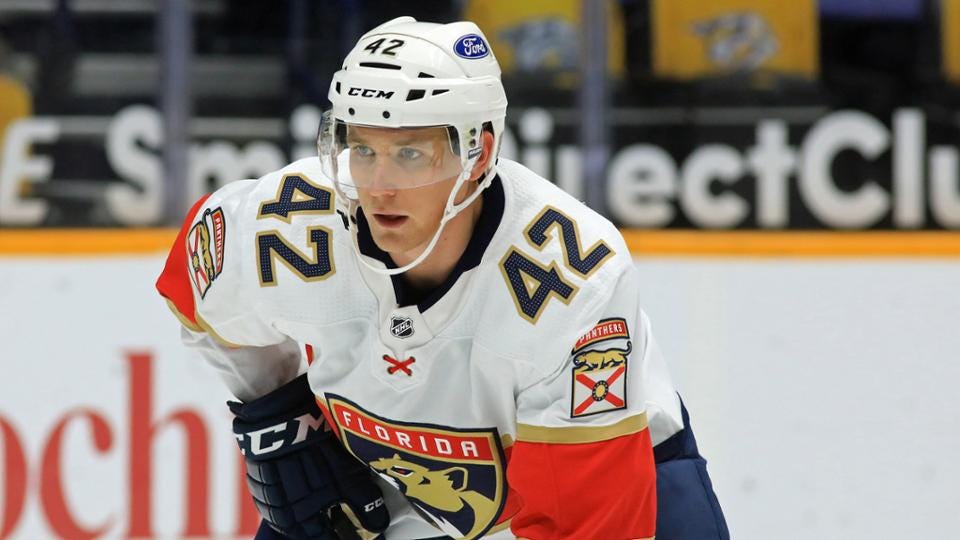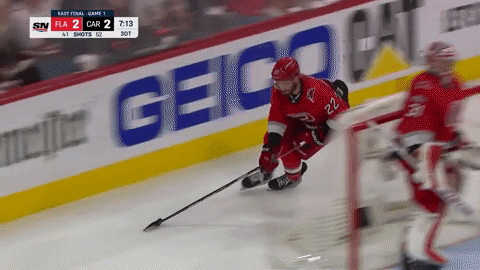How Gustav Forsling Helped the Panthers Bend But Not Break
Florida's unheralded defenseman shined in the Eastern Conference Final

Although the Florida Panthers swept the Carolina Hurricanes, this year’s Eastern Conference Final wasn’t as one-sided as the outcome suggests. Each game was decided by a single goal. Moreover, the Panthers were comfortably outshot and outchanced (43.6 CF%, 42.4 xGF%) throughout the series.
Sergei Bobrovsky is the Conn Smythe front-runner for good reason.
With that said, another Panther was instrumental to the club’s stinginess. Here’s how Gustav Forsling thwarted the Hurricanes’ offense in Round 3.
NZ Aggressiveness
Unlike with most teams, forcing the Hurricanes to chip pucks in isn’t a victory because they don’t particularly care about controlled entries. They’re the league’s dump-and-chase kings.
They want to roll up their sleeves, dig in the corners and attack from there. They wear you down through repetition. Attrition.
Therefore, the opposition should aim to limit the number of battles it has to take part in. Forsling did a top-notch job of this by unsettling the forecheck’s rhythm at the root. As an effortless skater, the 26-year-old pressed up on the Canes’ forwards in the neutral zone to hinder dump-in attempt after dump-in attempt.
Watch how aggressive his positioning is:
Ideally, you’d keep the Hurricanes out of your zone altogether, but it isn’t the end of the world if a puck squeaks by.
Disruption is the name of the game. Florida was in excellent shape as long as it could affect the velocity of either the puck or the first forechecker. Muffling or delaying the dump-in throws the entire operation out of sync. Consider this example from Game 1:
After rimming the puck out, the Canes face a three-on-three in the neutral zone. They would typically relish this setup. One touch, and they overwhelm you. Instead, Forsling stands up at the red line—in triple overtime, no less—and kills the forecheck before it ever materializes. Jordan Martinook (CAR 48) is so prepared to swarm the Panthers that the change of direction sends him tumbling to the ice.
That’s how Forsling was able to quiet the Hurricanes’ storm. He took their speed out of the equation and strong-armed them into regrouping early and often. Now their pressure arrived later, their layers weren’t as well-defined and Florida’s breakout enjoyed more time to develop.
Consequently, he didn’t concede much. He, partner Aaron Ekblad, Brandon Montour and Marc Staal absorbed the tough matchups in Round 3, but one rearguard’s defensive numbers leap off the screen despite unfavorable deployment (OZS%):
Forsling: 12.04 HDCA/60, 2.34 xGA/60, 34.38 OZS%
Ekblad: 12.41 HDCA/60, 2.57 xGA/60, 35.14 OZS%
Montour: 20.07 HDCA/60, 4.66 xGA/60, 41.38 OZS%
Staal: 22.93 HDCA/60, 5.54 xGA/60, 43.33 OZS%
Forsling obviously didn’t stave off every Hurricanes dump-in, but he was far more successful at it than his counterparts. He pushed back rather than retreating, and this daring approach paid off in spades.
Carolina frequently couldn’t find its groove because Forsling was standing in it.
Last Line of Defense
For a Stanley Cup finalist, Florida doesn’t possess the soundest defensive structure. When you remember how much energy it expends on its own forecheck, that makes sense. Still, if you can gain access to the offensive zone, opportunities abound.
Carolina enjoyed a fair deal of space throughout the four-game series, but it couldn’t tickle the twine.
While much of that can be attributed to Bobrovsky’s heroics, Forsling also played a major part in Florida’s lockdown. His mobility and pesky stick work allow him to close the distance quickly, whether that means impeding shooters before they pull the trigger or absorbing their bids afterward.
He just knows how to…get in the way:
Once again, Forsling’s proactive nature shines here. The 6’0”, 186-pound blueliner is a deceptively stout net-front defender who sorts out his assignment and faceguards them as soon as possible. As such, he’s interrupting their path—not chasing after their trail.
Hockey is a game of inches, and his talent for diverting his man for a few ticks can represent the difference between easy saves and a slew of screened or second-chance opportunities.
Moreover, he strikes a nice balance between tenacious coverage and swift threat identitication. He knows when to clamp on to a target and when to disengage and scan for the bigger picture. Look at this sequence from Game 4:
Maybe Forsling has dealt with Nikita Kucherov enough not to fall for the one-timer fake from the flank. Regardless, the fast-twitch defenseman doesn’t overreact to the setup pass, sitting in the slot to deny the more dangerous option. Thanks to those smarts, he can bail the Panthers out in otherwise sticky situations (the penalty kill, odd-man rushes, goal-mouth scrambles, etc.).
The result? Among all defensemen who have logged 70+ minutes in Round 3, only he, Ekblad and Vegas’ third pairing of Nicolas Hague and Zach Whitecloud have blanked their opponents outright:

Bypassing him was already a tall task in the neutral zone. Add his diligent coverage and keen hockey sense into the mix (alongside extraordinary goaltending), and you’ve got a fortress to contend with.
Forsling doesn’t belong in the same conversation as Bobrovsky and Matthew Tkachuk. Those two are operating in rarefied air right now. He’s perhaps the most underrated defenseman in the sport, though, and he was nothing short of outstanding in the Eastern Conference Final.
If not for his fine work, the Panthers would still be in it.





